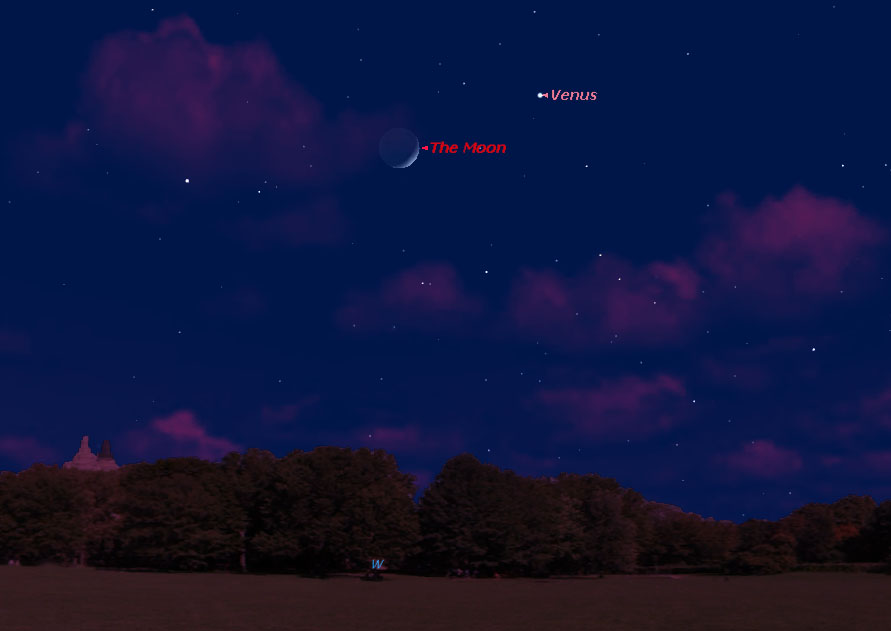See Venus and the Moon Shine Bright Tonight

On Thursday evening (May 21) as darkness falls, the two brightest objects of the night will be calling attention to themselves in the western sky. Thecrescent moon will be accompanied by the brightest planet, the dazzling so-called "evening star": the planet Venus.
Venus and the moon will not be particularly close to each other, but weather permitting, the celestial pair should make for a stunning night sky scene. Venus will appear to hover roughly 8 degrees to the moon's upper right (your clenched fist held at arm's length measures about 10 degrees). The moon, meanwhile, will be just 16-percent illuminated as a slender crescent. Yet, even though they're not overly close, their brightness forces even those who normally do not pay much attention to the sky to look up.
What we're seeing is an optical illusion of sorts. The moon and Venus are nowhere near to each other. The moon, our nearest neighbor in space is 242,500 miles (390,200 kilometers) away, while Venus, the planet that can approach us closer than any of the other planets is currently about 320 times farther away at 77.7 million miles (125 million km). It just so happens that on Thursday evening, they will appear near to each other in our sky. [The Must-See Night Sky Events of 2015]
Which object shines brighter? It might seem that Venus glows more brightly than the slender lunar sliver, but in truth it is really the moon. It shines at a magnitude-8.3, which is nearly 44 times brighter than Venus (shining at magnitude -4.2). What makes Venus more brilliant is probably due to the fact that its brightness is concentrated into a point of light to the eye, while the moon is considerably larger in angular size and its brightness is thus spread out over a larger area.
Look also for Earthshine; sunlight that is reflected off the Earth and directed toward the moon. That reflected light from the Earth is what is dimly illuminating the dark part of the moon with a grayish-blue light, almost imparting a three-dimensional effect to the moon particular in binoculars or a small telescope.
Currently, Venus is near the pinnacle of its evening visibility. By the end of May, it will begin to slide back toward the sun. Right now it is setting about three and a half hours after sunset. By mid-June, that difference will be reduced to three hours, and by the end of June it will be down to two and a half hours. By the second week of July, Venus will be setting before the end of evening twilight, and by the end of July, it will be setting less than an hour after sunset.
Venus will be gone from our evening sky by early August. So enjoy it now, and especially on Thursday when it will make for a lovely sight with our moon.
Breaking space news, the latest updates on rocket launches, skywatching events and more!
Editor's note:If you snap a great photo of Venus and the moon, or any other night sky scene, and would like to share it for a potential story or gallery, send images and comments in to Space.com at: spacephotos@space.com.
Joe Rao serves as an instructor and guest lecturer at New York's Hayden Planetarium. He writes about astronomy for Natural History magazine, the Farmer's Almanac and other publications, and he is also an on-camera meteorologist for News 12 Westchester, N.Y.Follow us @Spacedotcom, Facebook and Google+. Original article on Space.com.

Joe Rao is Space.com's skywatching columnist, as well as a veteran meteorologist and eclipse chaser who also serves as an instructor and guest lecturer at New York's Hayden Planetarium. He writes about astronomy for Natural History magazine, Sky & Telescope and other publications. Joe is an 8-time Emmy-nominated meteorologist who served the Putnam Valley region of New York for over 21 years. You can find him on Twitter and YouTube tracking lunar and solar eclipses, meteor showers and more. To find out Joe's latest project, visit him on Twitter.
